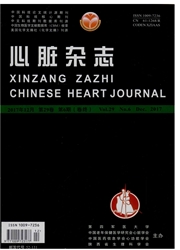

 中文摘要:
中文摘要:
目的:研究入院时血小板与淋巴细胞比率(Platelet-to-Lymphocyte Ratio,PLR)对急性ST段抬高型心肌梗死(ST-segment elevation myocardia1 infarction,STEMI)患者冠脉介入治疗后无复流的预测价值。方法:共收集190例急性STEMI患者,发病12小时内并且行PCI(primary coronary intervention)术。按术中TIMI血流分级将病人分为2组:正常复流组(138例)和无复流组(52例),比较两组患者的基本临床资料、实验室检查结果及PCI结果,用Logistic回归分析无复流的预测因素,用受试者工作特征曲线(ROC曲线)论证得到PLR预测无复流的最佳临界值及其敏感度和特异度。结果:无复流组PLR显著高于正常复流组(246±98VS 169±108,P〈0.01)。当PLR=188时,预测无复流的敏感度为70%,特异度为72%。结论:入院时PLR是急性STEMI患者PCI术后无复流的预测因素。
 英文摘要:
英文摘要:
Objective: To analyze the predictive effect of platelet-to-lymphocyte ratio(PLR) on admission in patients with on no-reflow phenomenon after primary coronary intervention(PCI). Methods: A total of 190 patients with acute STEMI occurring within12 hours who underwent primary PCI were enrolled. According to the TIMI flow grade during PCI, all the cases were divided into normal flow group(138 cases) and no-reflow group(52 cases). Basic clinical data, laboratory parameters and the results of PCI were compared between two groups. Logistic regression analysis was used to evaluate predictive value of PLR for no-reflow phenomenon after PCI. The ROC curve was used to demonstrate the optimal cut-off value, sensitivity and specificity of PLR on no-reflow phenomenon. Results: The no-reflow group had significantly higher PLR compared with the normal-reflow group(246±98 VS 169±108, P〈0.01). A cut-off point of 188 predicted no reflow with a insensitivity of 70 % and specificity of 72 %. Conclusion: Platelet-to-lymphocyte ratio on admission was a predictor of no-reflow in patients with acute STEMI after PCI.
 同期刊论文项目
同期刊论文项目
 同项目期刊论文
同项目期刊论文
 期刊信息
期刊信息
